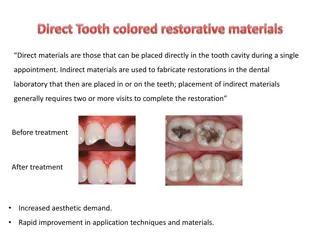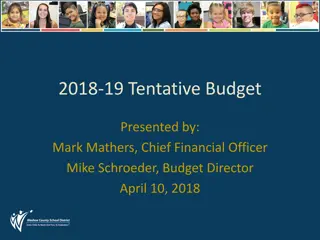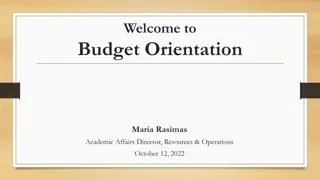Composite Benefit Rates in Budget Planning
Composite Benefit Rates (CBR) aggregate individual benefit components and costs to simplify budgeting in organizations. CBR represents benefits as a percentage of payroll, charging a single rate based on employee groupings. This approach maintains the overall cost of benefits but can shift expenses between departments. Not all benefits are included in CBR, such as accrued vacation leave and UCRP interest expenses. By using standardized rates, Budget & Planning can model different pooling scenarios to minimize budget impacts across departments and funds.
Download Presentation

Please find below an Image/Link to download the presentation.
The content on the website is provided AS IS for your information and personal use only. It may not be sold, licensed, or shared on other websites without obtaining consent from the author. Download presentation by click this link. If you encounter any issues during the download, it is possible that the publisher has removed the file from their server.
E N D
Presentation Transcript
CompositeBenefits Update Office of Budget & Planning 1
Background What is a Composite Benefit Rate (CBR)? A CBR aggregates individual benefit components and costs across a given employee population and represents them as a percentage of payroll. This percentage becomes the benefit rate that is charged. Based on employee groupings, employer paid benefits are pooled, then charged at a single rate rather than the multiple charges currently assessed. The benefit of this method is that it simplifies budgeting, but disassociates real costs from what is charged to a department or fund source. CBR costs are allocated to a department using a single object code. Office of Budget & Planning 2
Background Composite Benefit Rates Do Not... Change the campus cost of benefits; however, the pooling approach can shift expenses between departments and funds Change an employee s eligibility for benefits Change an employee s contribution to benefit programs Office of Budget & Planning 3
Background Benefits included in CBR: UC Contributions (Employer Paid) towards: o Medical, Dental and Vision Insurance o Medicare & OASDI taxes o Post-Employment Health Benefits o Pension & Other Retirement Contributions o Worker s Compensation Insurance o Unemployment Insurance o Disability Insurance o Life Insurance o Benefits Administration Not included in CBR: Accrued vacation leave (separate rate) UCRP interest expense (separate rate) Tuition remission Graduate Student Health Insurance General, Automotive, and Employee Insurance (GAEL) Other taxable income benefits not listed in inclusions Office of Budget & Planning 4
Impact Analysis Using 2016-17 actuals, Budget & Planning modeled a number of pooling scenarios looking to minimize the budget impacts between departments/funds. The option chosen was to use the 9 standard UC-defined rates, plus one campus wild card rate (*): Faculty Faculty Summer Salary No Eligibility Other Academic Partial Benefit Eligibility Staff Exempt Student *Police & Fire Post-Doc Staff Non-Exempt Rates for each pool have been approved by the DHHS (for 2018-19 and 2019-20). Office of Budget & Planning 5
2018-19 Rates Benefits (Approved by DHHS) Faculty Faculty Summer Salary 9.9% No Eligibility Other Academic Partial Benefit Eligibility 12.3% 35.2% Staff Exempt Student *Police & Fire Post-Doc 44.9% 22.8% 41.5% 4.3% Staff Non-Exempt 58.1% 1.9% 33.1% Vacation Accrual Eligible Not Eligible 8.61% 0.00% UCRP Interest Expense Federal fund sources Non-federal funds sources 0.00% 0.65% Office of Budget & Planning 6
Effective CBR Accounting for Vacation taken changed with UCPath Employee salaries & wages during vacation are reclassified from REG pay earn code to VAC pay earn code. For monthly employees this is recorded the month after vacation is taken. For bi-weekly employee s this is recorded in the current pay cycle. VAC earn code is not assessed CBR. This has the effect of reducing the salaries and wages assessment base and thereby reduces the CBR amount. Office of Budget & Planning 7
Effective CBR Example Example: Employee within Staff Exempt group earning $60,000/yr that takes 80 hours vacation in one year (equiv. $2,299 VAC pay). Sub 1 Salary Expense Scenario w/o Vacation Scenario with Vacation Salary: REG (Object Code 1100) 60,000 57,701 Salary: VAC (OC 1950)* - 2,299 Total Salary Expense 60,000 60,000 *CBR not assessed on this amount Office of Budget & Planning 8
Effective CBR Example Sub 6 Benefits Expense Scenario w/o Vacation Scenario with Vacation CBR Assessment (OC 8855) Salary: REG 60,000 57,701 Composite Benefits Rate 44.9% 44.9% Composite Benefits Assessment 26,940 25,908 Vacation Leave Assessment (OC 8930) Salary: REG 60,000 57,701 Vacation Leave Assessment Rate 8.61% 8.61% VLA Expense 5,166 4,968 Office of Budget & Planning 9
Effective CBR Example Sub 6 Benefits Expense Scenario w/o Vacation Scenario with Vacation Vacation Usage Credit (OC 8931)* - (2,299) * Should match VAC entry in Sub 1 UCRP Supplemental Interest Assessment (OC 8690)* Salary: REG + VAC 60,000 60,000 UCRP IA 0.65% 0.65% UCRP Interest Assessment 390 390 * UCRP Interest Assessment is applied to VAC EARN code. Office of Budget & Planning 10
Effective CBR Example With Vacation Without Vacation Effective CBR % Total Sub 6 Benefits Expense* CBR % CBR $ CBR $ CBR 44.9% 26,940 25,908 43.2% VLA 8.61% 5,166 4,968 8.28% Vacation Usage Credit n/a - (2,299) n/a UCRP IA 0.65% 390 390 0.65% Total Sub 6 54.2% 32,496 28,967 48.3% Total Gross Salary + Benefits 92,496 88,967 Effective CBR becomes 43.2%, down from 44.9%. *Other expenses such as GAEL are not included in this example. Office of Budget & Planning 11
Mitigation Plan Update Budget & Planning have modelled anticipated impacts of CBR, both positive and negative for all funds across campus We are working in consultation with the Academic Senate Council on Research and Instructional Resources to form a committee of academic and administrative representatives to review the mitigation plan proposal and ensure consistency when applied Additional details on the mitigation plan will be shared after review by the committee Office of Budget & Planning 12
UCPath Known Issues CBR issues: Some instances of incorrect CBR being assessed e.g. Limited being assessed full Non-exempt rate. Report to UC Path Center, and work with HR/AP. CBR applied to Overtime/Stipend earn codes This appears to be intentional. o o VLA and Vacation issues: Recall Faculty Fix is in place with UC Path Center, Accounting to create FJs for corrections Limited Employees Issue needs system wide fix. UC Path Center working on solution Rehired Retirees Working with UC Path Center to find a solution Academic Chairs/Stipends Issue presented to UC Path Center, no solution available yet Vacation credits applied to incorrect account/funds Issue presented to UC Path Center, no solution available yet Terminal Vacation Pay (TRM) issue affecting centrally funded benefits fix being analyzed o o o o o o Office of Budget & Planning 13



























